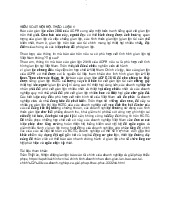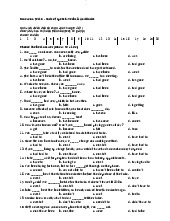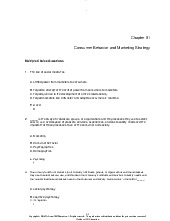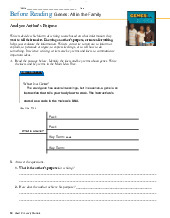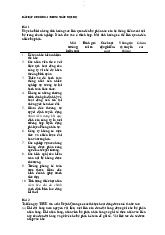



















Preview text:
lOMoARcPSD|472 065 21 lOMoARcPSD|472 065 21
Chapter 22 - Options and Corporate Finance Chapter 22
Options and Corporate Finance
Multiple Choice Questions
1. A financial contract that gives its owner the right, but not the obligation, to buy or sell a
specified asset at an agreed-upon price on or before a given future date is called a(n) _____ contract. A. option B. futures C. forward D. swap E. straddle
2. The act where an owner of an option buys or sells the underlying asset, as is his right, is called ______ the option. A. striking B. exercising C. opening D. splitting E. strangling
3. The fixed price in an option contract at which the owner can buy or sell the
underlying asset is called the option's: A. opening price. B. intrinsic value. C. strike price. D. market price. E. time value.
4. The last day on which an owner of an option can elect to exercise is the _____ date. A. ex-payment B. ex-option C. opening D. expiration E. intrinsic 22-1 lOMoARcPSD|472 065 21
Chapter 22 - Options and Corporate Finance
5. An option that may be exercised at any time up to its expiration date is called a(n) _____ option. A. futures B. Asian C. Bermudan D. European E. American
6. An option that may be exercised only on the expiration date is called a(n) _____ option. A. European B. American C. Bermudan D. futures E. Asian
7. A _____ is a derivative security that gives the owner the right, but not the obligation, to
buy an asset at a fixed price for a specified period of time. A. futures contract B. call option C. put option D. swap E. forward contract
8. A _____ is a derivative security that gives the owner the right, but not the obligation, to
sell an asset at a fixed price for a specified period of time. A. futures contract B. call option C. put option D. swap E. forward contract 22-2 lOMoARcPSD|472 065 21
Chapter 22 - Options and Corporate Finance
9. A trading opportunity that offers a riskless profit is called a(n): A. put option. B. call option. C. market equilibrium. D. arbitrage. E. cross-hedge.
10. The value of an option if it were to immediately expire, that is, its lower pricing bound,
is called an option's _____ value. A. strike B. market C. volatility D. time E. intrinsic
11. The relationship between the prices of the underlying stock, a call option, a put
option, and a riskless asset is referred to as the _____ relationship. A. put-call parity B. covered call C. protective put D. straddle E. strangle
12. The effect on an option's value of a small change in the value of the underlying asset is called the option: A. theta. B. vega. C. rho. D. delta. E. gamma. 22-3 lOMoARcPSD|472 065 21
Chapter 22 - Options and Corporate Finance
13. An option that grants the right, but not the obligation, to sell shares of the underlying
asset on a particular date at a specified price is called:
A. either an American or a European option. B. an American call. C. an American put. D. a European put. E. a European call.
14. Which one of the following provides the option of selling a stock anytime during
the option period at a specified price even if the market price of the stock declines to zero? A. American call B. European call C. American put D. European put
E. either an American or a European put
15. Given an exercise price, time to maturity, and European put-call parity, the present
value of the strike price plus the call option is equal to:
A. the current market value of the stock.
B. the present value of the stock minus a put option.
C. a put option minus the market value of the share of
stock. D. the value of a U.S. Treasury bill.
E. the share of stock plus the put option.
16. You can realize the same value as that derived from stock ownership if you:
A. sell a put option and invest at the risk-free rate of return.
B. buy a call option and write a put option on a stock and also borrow funds at the risk- free rate.
C. sell a put and buy a call on a stock as well as invest at the risk-free rate of return.
D. lend out funds at the risk-free rate of return and sell a put option on the stock.
E. borrow funds at the risk-free rate of return and invest the proceeds in equivalent amounts of put and call options. 22-4 lOMoARcPSD|472 065 21
Chapter 22 - Options and Corporate Finance
17. Which one of the following statements correctly describes your situation as the owner of an American call option?
A. You are obligated to buy at a set price at any time up to and including the expiration date.
B. You have the right to sell at a set price at any time up to and including the expiration
date. C. You have the right to buy at a set price only on the expiration date.
D. You are obligated to sell at a set price if the option is exercised.
E. You have the right to buy at a set price at any time up to and including the expiration date.
18. Jeff opted to exercise his August option on August 10 and received $2,500 in exchange
for his shares. Jeff must have owned a (an): A. warrant. B. American call. C. American put. D. European call. E. European put.
19. Jillian owns an option which gives her the right to purchase shares of WAN stock at a
price of $20 a share. Currently, WAN stock is selling for $24.50. Jillian would like to profit
on this stock but is not permitted to exercise her option for another two weeks.
Which of the following statements apply to this situation?
I. Jillian must own a European call option.
II. Jillian must own an American put option.
III. Jillian should sell her option today if she feels the price of WAN stock will
decline significantly over the next two weeks.
IV. Jillian cannot profit today from the price increase in WAN stock. A. I and III only B. II and IV only C. I and IV only D. II and III only E. I, III, and IV only 22-5 lOMoARcPSD|472 065 21
Chapter 22 - Options and Corporate Finance
20. The difference between an American call and a European call is that the American call:
A. has a fixed exercise price while the European exercise price can vary within a small
range. B. is a right to buy while a European call is an obligation to buy.
C. has an expiration date while the European call does not.
D. is written on 100 shares of the underlying security while the European call covers 1,000 shares.
E. can be exercised at any time up to the expiration date while the European call can only
be exercised on the expiration date.
21. If a call has a positive intrinsic value at expiration the call is said to be: A. funded. B. unfunded. C. at the money. D. in the money. E. out of the money.
22. A put option with a $35 exercise price on ABC stock expires today. The current price of ABC stock is $36. The put is: A. funded. B. unfunded. C. at the money. D. in the money. E. out of the money.
23. The maximum value of a call option is equal to:
A. the strike price minus the initial cost of the option.
B. the exercise price plus the price of the underlying stock. C. the strike price.
D. the price of the underlying stock. E. the purchase price. 22-6 lOMoARcPSD|472 065 21
Chapter 22 - Options and Corporate Finance
24. The lower bound on a call's value is either
the: A. strike price or zero, whichever is greater.
B. stock price minus the exercise price or zero, whichever is
greater. C. strike price or the stock price, whichever is lower.
D. strike price or zero, whichever is lower.
E. stock price minus the exercise price or zero, whichever is lower.
25. The lower bound of a call option:
A. can be a negative value regardless of the stock or exercise prices.
B. can be a negative value but only when the exercise price exceeds the stock price.
C. can be a negative value but only when the stock price exceeds the exercise price. D. must be greater than zero. E. can be equal to zero.
26. The intrinsic value of a call is:
I. the value of the call if it were about to expire.
II. equal to the lower bound of a call's value.
III. another name for the market price of a call.
IV. always equal to zero if the call is currently out of the money. A. I and III only B. II and IV only C. I and II only D. II, III, and IV only E. I, II, and IV only
27. The intrinsic value of a put is equal to the:
A. lesser of the strike price or the stock price.
B. lesser of the stock price minus the exercise price or
zero. C. lesser of the stock price or zero.
D. greater of the strike price minus the stock price or zero. E.
greater of the stock price minus the exercise price or zero. 22-7 lOMoARcPSD|472 065 21
Chapter 22 - Options and Corporate Finance
28. Which of the following statements are correct concerning option values?
I. The value of a call increases as the price of the underlying stock increases.
II. The value of a call decreases as the exercise price increases.
III. The value of a put increases as the price of the underlying stock increases.
IV. The value of a put decreases as the exercise price increases. A. I and III only B. II and IV only C. I and II only D. II and III only E. I, II, and IV only
29. The value of a call increases when:
I. the time to expiration increases.
II. the stock price increases.
III. the risk-free rate of return increases.
IV. the volatility of the price of the underlying stock increases. A. I and III only B. II, III, and IV only C. I, III, and IV only D. I, II, and III only E. I, II, III, and IV
30. Which one of the following will cause the value of a call to
decrease? A. lowering the exercise price
B. increasing the time to expiration
C. increasing the risk-free rate
D. lowering the risk level of the underlying
security E. increasing the stock price 22-8 lOMoARcPSD|472 065 21
Chapter 22 - Options and Corporate Finance
31. Assume that you own both a May 40 put and a May 40 call on ABC stock. Which one
of the following statements is correct concerning your option positions? Ignore taxes and transaction costs.
A. An increase in the stock price will increase the value of your put and decrease the value of your call.
B. Both a May 45 put and a May 45 call will have higher values than your May 40
options. C. The time premiums on both your put and call are less than the time premiums on equivalent June options.
D. A decrease in the stock price will decrease the value of both of your options.
E. You cannot profit on your position as your profits on one option will be offset by losses on the other option.
32. You own both a May 20 call and a May 20 put. If the call finishes in the money, then the put will: A. also finish in the money. B. finish at the money. C. finish out of the money.
D. either finish at the money or in the money.
E. either finish at the money or out of the money.
33. You own stock in a firm that has a pure discount loan due in six months. The loan has a face
value of $50,000. The assets of the firm are currently worth $62,000. The stockholders in this
firm basically own a _____ option on the assets of the firm with a strike price of ______ A. put; $62,000. B. put; $50,000. C. warrant; $62,000. D. call; $62,000. E. call; $50,000. 22-9 lOMoARcPSD|472 065 21
Chapter 22 - Options and Corporate Finance
34. The owner of a call option has the:
A. right but not the obligation to buy a stock at a specified price on a specified date.
B. right but not the obligation to buy a stock at a specified price during a specified period of time.
C. obligation to buy a stock on a specified date but only at the specified price.
D. obligation to buy a stock sometime during a specified period of time at the specified
price. E. obligation to buy a stock at the lower of the exercise price or the market price on the expiration date.
35. In the Black-Scholes option pricing formula, N(d1) is the probability that a
standardized, normally distributed random variable is: A. less than or equal to N(d2). B. less than one. C. equal to one. D. equal to d1. E. less than or equal to d1.
36. To compute the value of a put using the Black-Scholes option pricing model, you:
A. first have to apply the put-call parity relationship.
B. first have to compute the value of the put as if it is a call.
C. compute the value of an equivalent call and then subtract that value from one.
D. compute the value of an equivalent call and then subtract that value from the market price of the stock.
E. compute the value of an equivalent call and then multiply that value by e-RT.
37. If you consider the equity of a firm to be an option on the firm's assets then the act of
paying off debt is comparable to _____ on the assets of the firm. A. purchasing a put option B. purchasing a call option
C. exercising an in-the-money put option
D. exercising an in-the-money call
option E. selling a call option 22-10 lOMoARcPSD|472 065 21
Chapter 22 - Options and Corporate Finance
38. For every positive net present value project that a firm undertakes, the equity in the
firm will increase the most if the delta of the call option on the firm's assets is: A. equal to one. B. between zero and one. C. equal to zero. D. between zero and minus one. E. equal to minus one.
39. Shareholders in a leveraged firm might wish to accept a negative net present value project if:
A. it increases the standard deviation of the returns on the firm's
assets. B. it lowers the variance of the returns on the firm's assets.
C. it lowers the risk level of the firm.
D. it diversifies the cash flows of the firm.
E. it decreases the risk that a firm will default on its debt.
40. Which of the following statements is true?
A. American options are options on securities of U.S. corporations, and the options are
traded on American exchanges. European options are options on securities of U.S.
corporations, but the options are traded on European exchanges.
B. American options are options on securities which are traded on American exchanges.
European options, also traded on American exchanges, are options on European
corporations. C. American options give the holder the right to the dividend payment. European options do not.
D. American options may be exercised anytime up to expiration. European options may be exercised only at expiration. E. None of the above.
41. An out-of-the-money call option is one that:
A. has an exercise price below the current market price of the underlying security. B. should not be exercised.
C. has an exercise price above the current market price of the underlying security. D. Both A and B. E. Both B and C. 22-11 lOMoARcPSD|472 065 21
Chapter 22 - Options and Corporate Finance
42. Which of the following is not true concerning call option writers?
A. Writers promise to deliver shares if exercised by the buyer.
B. The writer has the option to sell shares but not an obligation.
C. The writer's liability is zero if the option expires out-of-the-money.
D. The writer receives a cash payment from the buyer at the time the option is purchased. E.
The writer has a loss if the market price rises substantially above the exercise price.
43. An in-the-money put option is one that:
A. has an exercise price greater than the underlying stock price.
B. has an exercise price less than the underlying stock price.
C. has an exercise price equal to the underlying stock price.
D. should not be exercised at expiration.
E. should not be exercised at any time.
44. Which of the following statements is true?
A. At expiration the maximum price of a call is the greater of (Stock Price - Exercise) or 0.
B. At expiration the maximum price of a call is the greater of (Exercise - Stock Price) or 0.
C. At expiration the maximum price of a put is the greater of (Stock Price - Exercise) or 0.
D. At expiration the maximum price of a put is the greater of (Exercise - Stock Price) or 0. E. Both A and D.
45. Put-call parity can be used to show:
A. how far in-the-money put options can get.
B. how far in-the-money call options can get.
C. the precise relationship between put and call prices given equal exercise prices and equal expiration dates.
D. that the value of a call option is always twice that of a put given equal exercise prices and equal expiration dates.
E. that the value of a call option is always half that of a put given equal exercise prices and equal expiration dates.
Tele-Tech Com announces a major expansion into Internet services. This
announcement causes the price of Tele-Tech Com stock to increase, but also causes an
increase in price volatility of the stock. 22-12 lOMoARcPSD|472 065 21
Chapter 22 - Options and Corporate Finance
46. Which of the following correctly identifies the impact of these changes on a call option of Tele-Tech Com?
A. Both changes cause the price of the call option to decrease.
B. Both changes cause the price of the call option to increase.
C. The greater uncertainty will cause the price of the call option to decrease. The higher
price of the stock will cause the price of the call option to increase.
D. The greater uncertainty will cause the price of the call option to increase. The higher
price of the stock will cause the price of the call option to decrease.
E. The greater uncertainty has no direct effect on the price of the call option. The higher
price of the stock will cause the price of the call option to decrease.
47. Which of the following correctly identifies the impact of these changes on a put option of Tele-Tech Com?
A. Both changes cause the price of the put option to decrease.
B. Both changes cause the price of the put option to increase.
C. The greater uncertainty will cause the price of the put option to decrease. The higher
price of the stock will cause the price of the put option to increase.
D. The greater uncertainty will cause the price of the put option to increase. The higher
price of the stock will cause the price of the put option to decrease.
E. The greater uncertainty has no direct effect on the price of the put option. The higher
price of the stock will cause the price of the put option to decrease.
48. The delta of a call measures:
A. the change in the ending stock value.
B. the change in the ending option value.
C. the swing in the price of the call relative to the swing in stock price.
D. the ratio of the change in the exercise price to the change in the stock price. E. None of the above.
49. The Black-Scholes option pricing model is dependent on which five parameters? A.
Stock price, exercise price, risk free rate, probability, and time to maturity
B. Stock price, risk free rate, probability, time to maturity, and variance
C. Stock price, risk free rate, probability, variance and exercise price
D. Stock price, exercise price, risk free rate, variance and time to maturity E.
Exercise price, probability, stock price, variance and time to maturity 22-13 lOMoARcPSD|472 065 21
Chapter 22 - Options and Corporate Finance
50. What is the cost of five November 25 call option contracts on KNJ stock given the following price quotes? A. $615 B. $660 C. $2,500 D. $3,075 E. $3,300
51. What is the value of one November 35 put contract? A. $70 B. $460 C. $510 D. $4,600 E. $5,100 22-14 lOMoARcPSD|472 065 21
Chapter 22 - Options and Corporate Finance
52. What is the intrinsic value of the August 25 call? A. $0.10 B. $5.86 C. $6.15 D. $10.00 E. $25.00
53. You purchased six TJH call option contracts with a strike price of $40 when the option
was quoted at $1.30. The option expires today when the value of TJH stock is $41.90.
Ignoring trading costs and taxes, what is your total profit or loss on your investment? A. $60 B. $320 C. $360 D. $420 E. $540
54. You purchased four WXO 30 call option contracts at a quoted price of $.34. What is
your net gain or loss on this investment if the price of WXO is $33.60 on the option expiration date? A. -$1,576 B. -$136 C. $1,304 D. $1,440 E. $1,576 22-15 lOMoARcPSD|472 065 21
Chapter 22 - Options and Corporate Finance
55. You wrote ten call option contracts on JIG stock with a strike price of $40 and an option
price of $.40. What is your net gain or loss on this investment if the price of JIG is $46.05
on the option expiration date? A. -$6,450 B. -$5,650 C. $400 D. $5,650 E. $6,450
56. The market price of ABC stock has been very volatile and you think this volatility will
continue for a few weeks. Thus, you decide to purchase a one-month call option contract on
ABC stock with a strike price of $25 and an option price of $1.30. You also purchase a one-
month put option on ABC stock with a strike price of $25 and an option price of $.50. What
will be your total profit or loss on these option positions if the stock price is $24.60 on the day the options expire? A. -$180 B. -$140 C. -$100 D. $0 E. $180
57. Several rumors concerning Wyslow, Inc. stock have started circulating. These rumors are
causing the market price of the stock to be quite volatile. Given this situation, you decide to
buy both a one-month put and a one month call option on this stock with an exercise price of
$15. You purchased the call at a quoted price of $.20 and the put at a price of $2.10. What
will be your total profit or loss on these option positions if the stock price is $4 on the day the options expire? A. -$230 B. $870 C. $890 D. $910 E. $1,310 22-16 lOMoARcPSD|472 065 21
Chapter 22 - Options and Corporate Finance
58. Three months ago, you purchased a put option on WXX stock with a strike price of $60
and an option price of $.60. The option expires today when the value of WXX stock is
$62.50. Ignoring trading costs and taxes, what is your total profit or loss on your investment? A. -$310 B. -$60 C. $0 D. $60 E. $190
59. You sold ten put option contracts on PLT stock with an exercise price of $32.50 and an
option price of $1.10. Today, the option expires and the underlying stock is selling for
$34.30 a share. Ignoring trading costs and taxes, what is your total profit or loss on this investment? A. -$2,900 B. -$1,100 C. $700 D. $1,100 E. $2,900
60. You sold a put contract on EDF stock at an option price of $.40. The option had an
exercise price of $20. The option was exercised. Today, EDF stock is selling for $19 a share.
What is your total profit or loss on all of your transactions related to EDF stock assuming
that you close out your positions in this stock today? Ignore transaction costs and taxes. A. -$140 B. -$60 C. $40 D. $60 E. $140
61. You own two call option contracts on ABC stock with a strike price of $15. When you
purchased the contracts the option price was $1.20 and the stock price was $15.90. What is
the total intrinsic value of these options if ABC stock is currently selling for $14.50 a share? A. -$280 B. -$180 C. -$100 D. $0 E. $100 22-17 lOMoARcPSD|472 065 21
Chapter 22 - Options and Corporate Finance
62. You own five put option contracts on XYZ stock with an exercise price of $25. What
is the total intrinsic value of these contracts if XYZ stock is currently selling for $24.50 a share? A. -$250 B. -$50 C. $0 D. $50 E. $250
63. Last week, you purchased a call option on Denver, Inc. stock at an option price of $1.05.
The stock price last week was $28.10. The strike price is $27.50. What is the intrinsic value
per share if Denver, Inc. stock is currently priced at $29.03? A. -$1.05 B. $0 C. $.48 D. $.93 E. $1.53
64. Three weeks ago, you purchased a July 45 put option on RPJ stock at an option price of
$3.20. The market price of RPJ stock three weeks ago was $42.70. Today, RPJ stock is
selling at $44.75 a share and the July 45 put is priced at $.80. What is the intrinsic value of your put contract? A. -$295 B. -$210 C. $0 D. $25 E. $110
65. You own a call option on Jasper Co. stock that expires in one year. The exercise price is
$42.50. The current price of the stock is $56.00 and the risk-free rate of return is 3.5%.
Assume that the option will finish in the money. What is the current value of the call option? A. $13.04 B. $13.50 C. $13.97 D. $14.94 E. $15.46 22-18 lOMoARcPSD|472 065 21
Chapter 22 - Options and Corporate Finance
66. You currently own a one-year call option on Way-One, Inc. stock. The current stock price is
$26.50 and the risk-free rate of return is 4%. Your option has a strike price of $20 and you
assume that it will finish in the money. What is the current value of your call option? A. $6.25 B. $6.50 C. $6.76 D. $7.13 E. $7.27
67. The common stock of Mercury Motors is selling for $43.90 a share. U.S. Treasury
bills are currently yielding 4.5%. What is the current value of a one-year call option on
Mercury Motors stock if the exercise price is $37.50 and you assume the option will finish in the money? A. $6.12 B. $6.40 C. $6.69 D. $7.67 E. $8.01
68. The common stock of Winsson, Inc. is currently priced at $52.50 a share. One year from
now, the stock price is expected to be either $54 or $60 a share. The risk-free rate of return
is 4%. What is the value of one call option on Winsson stock with an exercise price of $55? A. $0.39 B. $0.41 C. $0.45 D. $0.48 E. $0.51 22-19 lOMoARcPSD|472 065 21
Chapter 22 - Options and Corporate Finance
69. You own one call option with an exercise price of $30 on Nadia Interiors stock. This
stock is currently selling for $27.80 a share but is expected to increase to either $28 or $34 a
share over the next year. The risk-free rate of return is 5% and the inflation rate is 3%. What
is the current value of your option if it expires in one year? A. $0.76 B. $0.79 C. $0.89 D. $0.92 E. $0.95
70. The assets of Blue Light Specials are currently worth $2,100. These assets are expected to
be worth either $1,800 or $2,300 one year from now. The company has a pure discount bond
outstanding with a $2,000 face value and a maturity date of one year. The risk-free rate is
5%. What is the value of the equity in this firm? A. $166.67 B. $231.42 C. $385.71 D. $405.00 E. $714.29
71. Big Ed's Electrical has a pure discount bond that comes due in one year and has a face
value of $1,000. The risk-free rate of return is 4%. The assets of Big Ed's are expected to be
worth either $800 or $1,300 in one year. Currently, these assets are worth $1,140. What is
the current value of the debt of Big Ed's Electrical? A. $222.46 B. $370.77 C. $514.28 D. $769.23 E. $917.54 22-20
